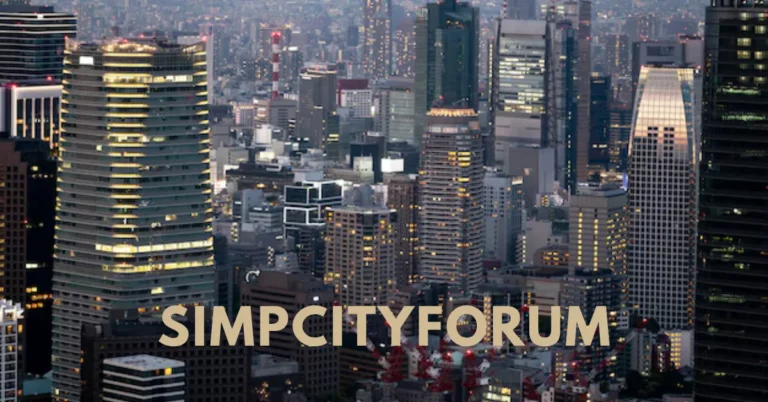Introduction to simpcityforum and its mission
Welcome to simpcityforum, the hub where innovative urban design meets practical solutions for modern cities. Our mission is clear: to inspire and empower individuals and communities to rethink how we build our urban environments. As populations grow and technology advances, cities face new challenges that call for fresh perspectives.
Have you ever wandered through a vibrant city street or enjoyed a peaceful park amidst towering skyscrapers? These experiences reflect what we define as dynamic metropolises—cities that thrive on diversity, adaptability, and sustainability. Join us as we explore the exciting world of dynamic metropolises and discover how simpcityforum can help shape your city’s future!
Understanding the concept of dynamic metropolises
Dynamic metropolises are cities that thrive on change, adapting to the shifting needs of their residents. They pulse with energy and innovation, offering a vibrant mix of culture, technology, and community engagement.
At the heart of this concept is flexibility. A dynamic city can evolve its infrastructure in response to population growth or economic shifts. This adaptability fosters an environment where creativity flourishes.
Moreover, dynamic metropolises prioritize public spaces. Parks, plazas, and communal areas invite interaction among citizens. These spaces serve as catalysts for social cohesion and cultural exchange.
Technology plays a crucial role too. Smart urban solutions enhance transportation efficiency and sustainability efforts while connecting people in new ways.
Dynamic metropolises redefine urban living by creating environments that promote collaboration and inclusivity—ensuring every voice contributes to the city’s narrative.
Factors that contribute to a city’s dynamism
A city’s dynamism hinges on several key factors. One crucial element is a vibrant economy. Diverse job opportunities attract residents and encourage innovation.
Another vital factor is accessibility. Well-planned public transportation systems ensure that people can move freely, connecting them to jobs, services, and leisure activities.
Cultural richness also plays an important role. Events, galleries, and local markets foster community engagement and create a unique identity for the city.
Green spaces contribute significantly as well. Parks and recreational areas not only enhance aesthetics but also improve mental health and social interactions among citizens.
Technology integration cannot be overlooked. Smart city initiatives enhance efficiency in urban management while promoting sustainable practices that benefit everyone living there.
Case studies of successful dynamic metropolises
Tokyo stands out as a prime example of a dynamic metropolis. Its intricate blend of traditional culture and cutting-edge technology creates an energetic atmosphere. The city’s efficient public transport system allows seamless movement, enhancing connectivity among residents.
Barcelona demonstrates how urban design can foster community interaction. Through pedestrian-friendly streets and vibrant plazas, the city encourages socialization and outdoor activities. Art installations sprinkled throughout enhance its cultural fabric.
Singapore embodies innovation in sustainability. Vertical gardens and eco-friendly architecture showcase its commitment to green living amidst rapid urbanization. The integration of nature within the concrete jungle promotes both aesthetic appeal and environmental health.
Copenhagen is another remarkable case study, prioritizing cycling infrastructure over cars. This shift not only reduces pollution but also fosters a sense of belonging among cyclists who navigate the city together daily.
These metropolises illustrate that diverse approaches can create thriving environments that resonate with residents while adapting to modern challenges.
Tips for designing a dynamic metropolis
Designing a dynamic metropolis requires a blend of creativity and practicality. Start with mixed-use spaces that encourage interaction among residents. These areas foster community, bringing together shops, apartments, and recreational facilities.
Next, prioritize green spaces. Parks and gardens not only enhance aesthetics but also contribute to mental well-being. They offer refuge amidst the urban hustle.
Invest in public transportation systems that are efficient and accessible. A reliable transit network reduces traffic congestion while connecting diverse neighborhoods.
Incorporate smart technology into city infrastructure. This can optimize energy use, reduce waste, and improve overall quality of life for inhabitants.
Encourage local art initiatives to bring character to different districts. Murals or installations can celebrate the culture and history unique to each area.
Involve citizens in the planning process through forums or surveys. Their input ensures developments meet community needs effectively.
Challenges and potential solutions for creating dynamic cities
Creating dynamic cities comes with a set of unique challenges. One major hurdle is the balance between growth and sustainability. Rapid urbanization can lead to overcrowding, pollution, and strain on infrastructure.
Transportation systems often lag behind population increases. This congestion not only frustrates residents but also affects local economies. Integrating efficient public transit options is essential for easing mobility issues.
Another challenge lies in community engagement. Many urban designs fail to consider the voices of those who inhabit these spaces. Encouraging participatory planning can help ensure that developments meet the needs of diverse populations.
Economic disparities can inhibit dynamism. Cities must foster inclusive development strategies that support all socioeconomic groups, ensuring everyone benefits from urban advancements.
By recognizing these hurdles and implementing innovative solutions like sustainable initiatives and collaborative governance, we can pave the way for truly vibrant metropolises.
The future of urban design and the role of Simplicityforum
The future of urban design is evolving rapidly. Cities are reimagining their spaces to enhance livability and sustainability.
Simplicityforum plays a pivotal role in this transformation. By promoting innovative ideas, it fosters collaboration among urban planners, architects, and community members.
As technology advances, smart city concepts gain traction. Integrating digital solutions into the urban fabric allows for more efficient resource management.
Simplicityforum encourages these integrations through workshops and discussions that ignite creativity. The platform thrives on sharing successful models from cities around the world.
Emphasizing adaptability is crucial for future metropolises. Urban areas must respond to changing demographics and environmental challenges effectively.
Engaging citizens in the design process will lead to vibrant communities that reflect diverse needs and desires. Simplicityforum champions this inclusive approach as a cornerstone of modern urban planning initiatives.
With its focus on dynamic interactions between people and their environments, Simplicityforum shapes tomorrow’s cities today.
Conclusion: Creating sustainable, livable, and dynamic cities for the future
Creating sustainable, livable, and dynamic cities for the future requires a collaborative approach that brings together various stakeholders. Cities must embrace innovation while respecting their unique cultural identities. By prioritizing green spaces, efficient public transport, and mixed-use developments, urban planners can foster environments where communities thrive.
simpcityforum stands at the forefront of this movement. Its mission is to inspire change through dialogue and design principles that emphasize sustainability and engagement. The organization encourages creativity in tackling urban challenges.
The journey toward dynamic metropolises involves learning from successful case studies around the globe. These examples show us what’s possible when cities prioritize adaptability and inclusivity.
As we look ahead, it’s clear that our urban landscapes will continue to evolve. With dedicated efforts focused on collaboration and forward-thinking strategies, we can create vibrant cities where people love to live work and play—cities that are not just built but designed with purpose for generations to come.
FAQs
1. What is Simpcityforum?
Simpcityforum is a platform dedicated to advancing urban design and planning by exploring and sharing innovative solutions for dynamic cities. It serves as a hub for discussing strategies that blend technology, sustainability, and community engagement to create vibrant, adaptable metropolises.
2. How does Simpcityforum help in city planning?
Simpcityforum provides resources, case studies, and expert insights to guide urban planners and community members. It promotes best practices in city design, focusing on flexibility, public spaces, and smart technologies to address the evolving needs of urban environments.
3. What are dynamic metropolises?
Dynamic metropolises are cities characterized by their ability to adapt and thrive amidst change. They integrate cultural vibrancy, technological innovation, and sustainable practices to foster a lively and inclusive urban experience.
4. Can you give examples of successful dynamic metropolises?
Yes, examples include Tokyo with its blend of tradition and modernity, Barcelona with its community-focused urban design, Singapore with its sustainable innovations, and Copenhagen with its emphasis on cycling infrastructure.
5. What future trends in urban design does Simpcityforum focus on?
Simpcityforum focuses on trends such as smart city technologies, sustainable urban practices, citizen engagement in planning, and the integration of green spaces. These trends aim to enhance livability, adaptability, and inclusivity in future urban environments.

